VOA慢速英语 2008 0428b
搜索关注在线英语听力室公众号:tingroom,领取免费英语资料大礼包。
(单词翻译)
VOICE ONE: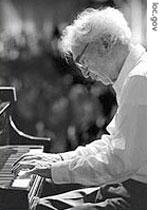 |
| Jazz musician Dave Brubeck |
Welcome to THIS IS AMERICA in VOA Special English. I'm Barbara Klein. This week on our program, we enter the world of jazz pianist Dave Brubeck. His group had the first jazz album to sell more than a million copies.
(MUSIC)
"Time Out," released in nineteen fifty-nine, also gave the world one of the best-known jazz tunes2 of all time. Written by saxophone player Paul Desmond, this is "Take Five."
(MUSIC)
This year is the fiftieth anniversary of another important event for the Dave Brubeck Quartet. In nineteen fifty-eight, the government sent the four musicians on a trip as part of a jazz ambassadors3 program.
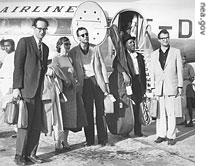 |
| Dave Brubeck (far right) and band arrive in India in 1958 |
They performed across Europe. They also played in Afghanistan, Pakistan and Ceylon (now Sri Lanka), as well as India, Iran, Iraq and Turkey.
The two-month trip provided new ideas. For example, seeing the Berlin Wall that divided Germany led Dave Brubeck to write "Brandenburg Gate."
(MUSIC)
Earlier this month, Dave Brubeck accepted a special award from the State Department for that trip and others he made later. Secretary of State Condoleezza Rice presented him with the first Ben Franklin Award for Public Diplomacy5.
She thanked him for representing America by bringing the language, the sounds and the spirit of jazz to people around the world.
(MUSIC)
The language of jazz includes hot jazz and cool jazz. Dave Brubeck is known for the cool kind. Jazz expert David Baker6 at Indiana University says cool jazz emphasizes the melody7 and is very relaxed. Professor Baker says hot jazz speaks to the heart; cool jazz speaks to the mind.
Here is an example from the Dave Brubeck Quartet, "In Your Own Sweet Way."
(MUSIC)
Jazz performers like to create as they play. This improvisation8 adds to the written music they bring with them. This is why the same piece can sound different each time the same musicians play it. David Baker says the written music is the subject of the piece. The improvisation is the explanation.
Jazz musicians may also change the traditional grouping of rhythms in a piece. This is especially true of Dave Brubeck's music. Much of it is written in unusual time signatures.
Traditional jazz pieces are written for dancing, with four beats to a measure. This means that the same four beats are played over and over again. Here is an example of this four-four time, the Dave Brubeck Quartet playing "The Duke":
(MUSIC)
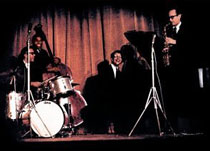 |
| Dave Brubeck Quartet at Carnegie Hall in 1963 |
Now, an example of an unusual time signature can be found in a piece called "Eleven Four." It was written by Paul Desmond, who also wrote "Take Five." "Eleven Four" has eleven beats to a measure. Dave Brubeck himself explained it at a concert at Carnegie Hall in New York in nineteen sixty-three.
DAVE BRUBECK: "We'd like to do this tune1 because of the title, 'Eleven Four.' You can guess that it's in eleven-four time. It was written by Paul. Again, the writing is very difficult, but that's not the problem. The problem is to improvise9 in eleven -- which we let Paul do mostly on this thing."
(MUSIC)
One of the quartet's greatest hits is in still another unusual time signature. "Blue Rondo a La Turk," written by Dave Brubeck, is in nine-eight time.
(MUSIC)
Dave Brubeck attended the College of the Pacific in Stockton, California. At first he studied with the aim to become a veterinarian. But his mind was clearly on music; during college, he played in jazz clubs at night. He graduated in nineteen forty-two with a music degree.
He served in World War Two. The Army sent him to entertain the troops in Europe.
In nineteen forty-seven, in San Francisco, he joined a jazz band where he met Paul Desmond. Desmond played the alto saxophone. He became a member of the Dave Brubeck Quartet when Brubeck formed the group in nineteen fifty-one. The quartet became known for playing what was called West Coast cool jazz at local colleges.
In nineteen fifty-four they recorded "Jazz Goes to College," their first album for Columbia Records. It sold more than one hundred thousand copies and made the group nationally known. The album included their version of "Take the A Train," written by Billy Strayhorn for Duke Ellington.
(MUSIC)
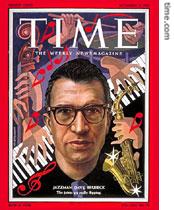 |
| Time magazine cover in 1954 honoring Dave Brubeck |
Also in nineteen fifty-four, Dave Brubeck was on the cover of Time magazine. The story said he was responsible for a "new kind of jazz age in the U.S." It described his music as "some of the strangest and loveliest music ever played since jazz was born."
In nineteen fifty-six, drummer Joe Morello and bass4 player Eugene Wright joined the quartet. The changes led to the group's most popular record, "Time Out," in nineteen fifty-nine. In addition to "Take Five," the album included "Three to Get Ready."
(MUSIC)
In nineteen sixty-seven the Dave Brubeck Quartet broke up. Dave Brubeck continued to write many different kinds of music -- classical symphonies10, ballets and religious songs. The father of six also worked with his four grown children who became jazz artists.
Today, at the age of eighty-seven, Dave Brubeck still composes and performs. He also heads the Brubeck Institute at the University of the Pacific.
The institute houses a collection of more than sixty years of his recordings11 and photographs. It also trains young musicians and works for social issues.
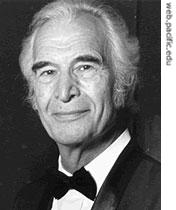 |
| Dave Brubeck |
On the Institute's Web site is a message from Dave Brubeck. He says he always sought the acceptance and recognition12 of jazz as a serious art form. Jazz reflects "American ideals of freedom and individual expression balanced with group responsibility and interdependence," he says.
And he adds that once, when asked how he would like to be remembered, he answered, "As someone who opened doors."
(MUSIC)
Our program was written by Nancy Steinbach and produced by Caty Weaver13. I'm Barbara Klein, hoping you can join us again next week for THIS IS AMERICA in VOA Special English. For transcripts14, MP3s and podcasts of our programs, go to voaspecialenglish.com.
 收听单词发音
收听单词发音 




